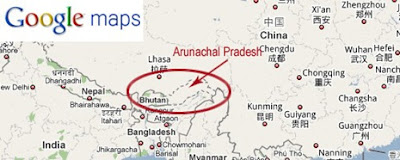This map via geocurrents shows India's disputed lands.
A draft law in India aims to punish cartographers who do not include the claimed territories as part of the country. From the Washington Post:
A few years ago Al Jazeera was banned for five days after showing a map that depicted Jammu and Kashmir as being divided between India, Pakistan and China. The media company was denounced for "cartographic aggression."
So how do the online map providers deal with these situations? A GIS Lounge article shows three different Google representations of the disputed state of Arunachal Pradesh, depending whether you are in India, China or the rest of the world (the last image.) While the rest of the world sees two parallel dashed lines, users in China and India see the border the way their governments want them to see it.
Apple maps (here in the United States) represents this border with two thin, unshaded lines. Note that there is another set of these along the Bhutan-China border. Last summer those two countries held their 23rd round of talks on this border.
Maps can be weapons.Be careful how you use them! I'll finish this with this nicely done map of Chinese "Intrusions" into India. I'm sure China has a different word for this. Click here for source.
A draft law in India aims to punish cartographers who do not include the claimed territories as part of the country. From the Washington Post:
Let's start with a basic fact: India claims much more land than it controls.The law would punish offenders with up to seven years of jail time and fines running from $150,000 to $15 million. That's a high price to pay for trying to represent reality.
Thus, any map of India and its neighbors makes an inherently political statement based on how it depicts their borders. The issue is particularly thorny because the border disputes are with India's great rivals: Pakistan and China.
A few years ago Al Jazeera was banned for five days after showing a map that depicted Jammu and Kashmir as being divided between India, Pakistan and China. The media company was denounced for "cartographic aggression."
So how do the online map providers deal with these situations? A GIS Lounge article shows three different Google representations of the disputed state of Arunachal Pradesh, depending whether you are in India, China or the rest of the world (the last image.) While the rest of the world sees two parallel dashed lines, users in China and India see the border the way their governments want them to see it.
Maps can be weapons.Be careful how you use them! I'll finish this with this nicely done map of Chinese "Intrusions" into India. I'm sure China has a different word for this. Click here for source.







No comments:
Post a Comment